ECommerce SEO Tips – How To Drive Traffic to Your Online Store?
Author :
- What Is eCommerce SEO?
- What is the Importance of eCommerce SEO?
- Why You Should Care About SEO for Your eCommerce Website
- Increased Visibility and Organic Traffic
- Improved User Experience
- Enhanced Brand Authority and Trust
- Increased Sales and Revenue
- Competitive Advantage
- What eCommerce SEO Entails
- Optimizing Collection and Product Pages
- Ensuring Product Feeds are Submitted via Google Merchant Center
- Building New Collection Pages to Target New Queries
- Speeding Up Page Load Time
- Creating Detailed Product Descriptions
- Doing Backlink Outreach
- 10 Best eCommerce SEO Tips to Drive Traffic
So, you’ve got an online store, awesome! But here’s the big question: how do you get people to visit it? Just building a cool website isn’t enough.
You need to make sure people can find it too. That’s where eCommerce SEO comes in! It’s all about helping your website show up on Google when someone searches for things you sell.
Imagine having a store in a busy market vs. a hidden alley. That’s how SEO puts you in the busy market! We’ll break down eCommerce SEO pretty thoroughly in this blog.
Moreover, we’ll feature smart eCommerce SEO tips that should boost traffic with fairly simple techniques. Also, we’re keeping things simple, so both freshers and experts can get on with this e-commerce SEO blog.
Let’s dive in and learn strategies to get clicks, customers, and sales for your online shop.
What Is eCommerce SEO?
eCommerce SEO is like giving your online store a map so people can find it easily on Google. It stands for Search Engine Optimization.
Moreover, eCommerce SEO optimization helps your website show up higher in search results when folks are looking for products online similar to the ones you sell.
SEO helps your store pop up in Google search results when someone types “buy red sneakers” if you happen to sell red sneakers online.
More so, eCommerce SEO tips are just covering the basics. Using the right keywords and crafting decent product descriptions while ensuring super smooth functionality on phones is pretty crucial basically nowadays.
Make stores super easy for search engines to understand. That will likely boost its ranking pretty significantly in search engine results thereby ensuring more online visibility.
Better SEO results in a marked increase in site visitors. Also, more visitors means more chances to sell!
What is the Importance of eCommerce SEO?
Without eCommerce SEO, your online store is like a shop in the middle of nowhere, hard to find! SEO boosts the visibility of your products remarkably by pushing your online store upwards in search engine rankings.
More folks will likely stumble upon your site and that too without using paid advertisements. It helps bring the right people who are actually looking for what you’re selling.
Good SEO enhances the functionality of your website making it faster and easier for users to navigate.
This culminates in lots of clicks and substantially enhanced customer experiences thereby heightening the chances of converting casual visitors into actual buyers. SEO is utterly essential for garnering steady traffic and good sales figures.
Why You Should Care About SEO for Your eCommerce Website
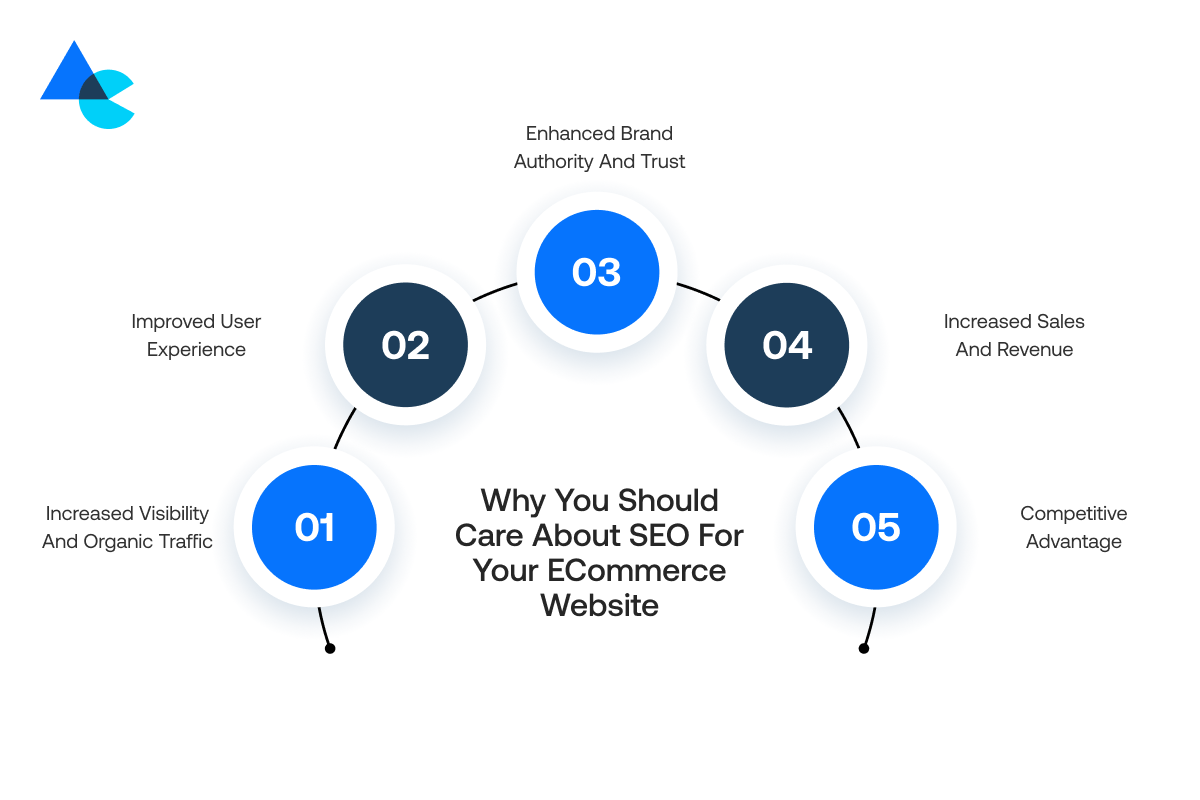
If you want more people to find your online store without paying for ads all the time, then SEO is something you really need to care about.
Here are a few benefits that looking after your eCommerce website’s SEO brings to your site:
Increased Visibility and Organic Traffic
Effective SEO boosts the visibility of your store on Google and thereby facilitates discovery by potential customers searching online for products you offer. A few benefits for increased visibility and organic traffic include:
- Higher Search Engine Rankings: Ranking higher on search engines means your store appears near top listings when someone searches for products that your store happens to sell online. Greater visibility means lots of clicks and lucrative sales opportunities.
- Targeted Traffic: SEO brings in lots of potential customers already searching online for products similar to yours with considerable enthusiasm. You’re getting the right visitors who are likely to buy something from you.
- Sustainable Traffic: SEO brings in traffic steadily over time whereas ads cease being effective when payment stops. SEO is akin to sowing seeds that flourish slowly under attention and nurturing over quite some time.
Improved User Experience
SEO doesn’t just help you show up in search results, it also makes your website work better for the people who visit it.
This means you get the following benefits:
- Faster Page Load Times: No one likes waiting! When your site loads quickly, people stay longer and shop more. Fast websites also rank higher on Google.
- Mobile-Friendly Design: Lots of people browse the net these days using their smartphones. A mobile-friendly site adjusts perfectly on small screens so users can browse stuff and make purchases easily.
- Easy Navigation: Intuitive navigation menus and organized pages facilitate effortless navigation of your website without users getting lost in dead ends. Ease of use boosts purchase likelihood substantially when users can navigate effortlessly without any fuss.
Enhanced Brand Authority and Trust
SEO boosts brand credibility quite significantly thereby fostering visitor confidence and making them likely to choose your brand over others.
Here’s what you get in terms of enhanced brand authority and trust:
- Credibility: Appearing on the first page of search results instantly lends credibility to your store and makes it seem downright trustworthy. People often trust top results more.
- Brand Awareness: Seeing your store in search results really helps people remember you even if they don’t make a purchase right then. That builds strong brand awareness gradually over time as well as fosters customer loyalty.
Increased Sales and Revenue
Boosting your store’s SEO can lead to more visitors but that’s merely part of what happens on various fronts. Great SEO turns visitors into paying customers, well helping your business grow at a fast rate.
These are some of the perks you get on the financial side of things:
- Higher Conversion Rates: People are more apt to make purchases when your website shows up in the right searches and is user-friendly. SEO helps attract buyers ready to make purchases thereby generating more orders and reducing bounce rates around your website. It’s a sweet deal boosting your sales big time.
- Cost-Effective Marketing: SEO may take some considerable time but costs relatively little compared to ad expenses over an extended period. Once your pages rank well, they will attract traffic organically without paying for every click and bringing in eager buyers ready to make a purchase.
- Increased Sales: Increased traffic usually means you get a greater chance of selling stuff on your website. SEO boosts traffic and purchases by delivering a seamless shopping experience as well as securing higher rankings. It turns clicks into cash.
Competitive Advantage
There are tons of online stores out there. But smart eCommerce SEO tips can make your store stand out remarkably from a crowded marketplace and stay rather ahead of the competition.
This is what we mean by that:
- Outranking Competitors: Stores ranking higher in search results get clicked on first by a ton of people. Good SEO enables you to beat competitors, especially big ones by showing up before them online when people search.
- Building a Strong Online Presence: SEO boosts brand visibility remarkably by building a strong digital footprint organically over time with various eCommerce SEO tips. Appearance of your website, blogs, and product pages in searches fosters trust and familiarity with potential customers. This strong presence keeps customers coming back to your store for more stuff.
What eCommerce SEO Entails
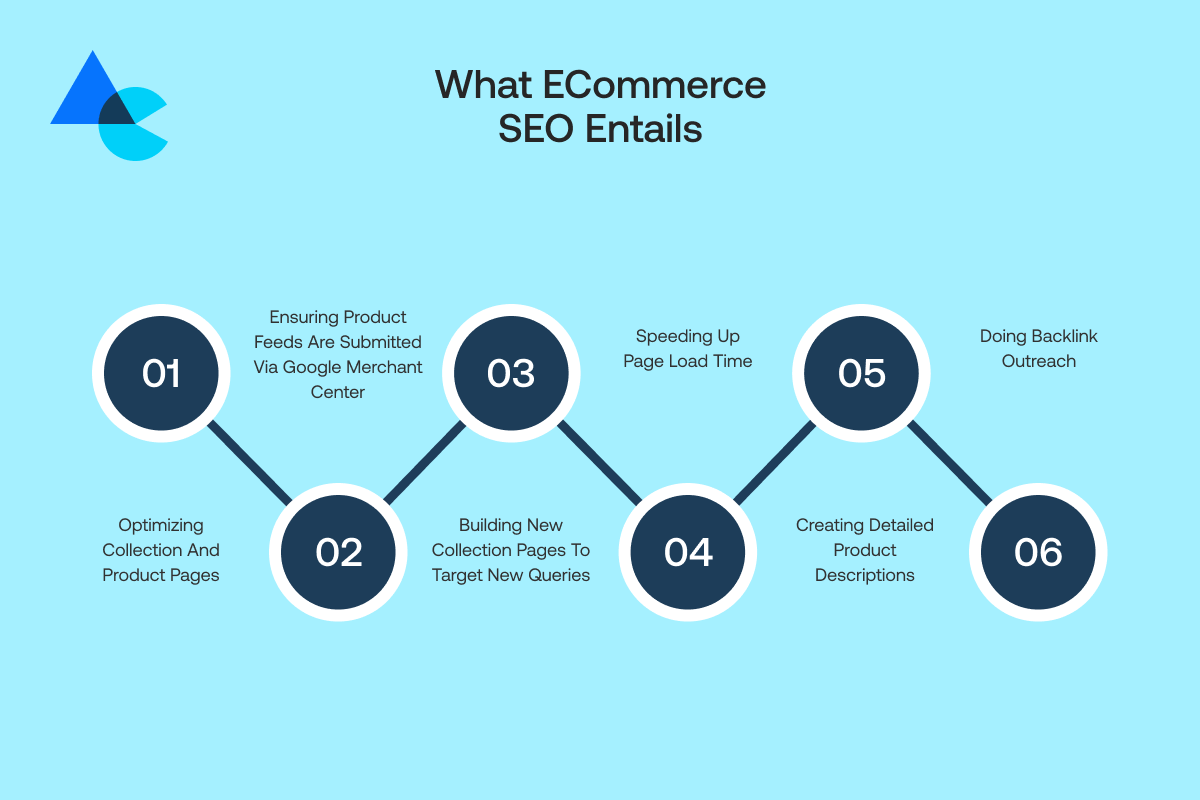
There’s more to SEO than just adding keywords. Here’s a breakdown of the key tasks involved in making sure your online store is fully optimized for search engines.
Optimizing Collection and Product Pages
Most shoppers land on product and collection pages that need to shine. Optimizing eCommerce website pages involves using the right keywords throughout titles descriptions and image alt text so Google accurately grasps what you’re selling online.
It also entails revamping the layout using clean URLs and adding useful content such as elaborate size guides and FAQs.
Doing SEO for eCommerce products helps your pages rank better and gives customers the info they need to buy.
Great product pages keep people interested, improve rankings, and boost sales. Think of them like your digital storefront, neat, clear, and welcoming!
Ensuring Product Feeds are Submitted via Google Merchant Center
Uploading product data feed into Google Merchant Center boosts the visibility of products in Google Shopping and various search ads.
You’re basically handing Google an inventory list of all the stuff you sell online. Details such as product names and images along with prices, availability, and lengthy descriptions are included in this feed.
It boosts your visibility quite significantly when shoppers search online for products similar to yours. It ensures listings stay updated pretty accurately meanwhile.
This process turbocharges targeted traffic and boosts visibility in shopping results making it easy for customers to find exactly what they need.
Building New Collection Pages to Target New Queries
Sometimes customers search for things you haven’t specifically created pages for, like “summer shoes” or “vegan skincare.”
That’s where new collection pages come in! Creating fresh content around specific search terms or trending topics attracts visitors searching for exactly those items online.
Filling SEO gaps effectively keeps you ahead of current search trends by staying informed of people’s online searches. Pages like these make a site feel rather more organized and relevant.
Over time, they can become strong traffic drivers that help your store appear in more search results without needing extra ads.
Speeding Up Page Load Time
Shoppers really hate websites that load slowly. People bail when pages load slow thereby never even laying eyes on your products.
Page speed plays a massively huge role in search engine optimization for many online marketers.
Faster sites get better rankings from search engines as well. Speed can be improved by heavily compressing images thoroughly and leveraging super reliable hosting with unnecessary code brutally removed.
A speedy website keeps people happy and ranks higher on Google quite effortlessly. Making these adjustments is straightforward and makes a pretty massive impact on visitor retention and getting them in the first place.
Creating Detailed Product Descriptions
A great product description convincingly sells stuff by featuring benefits, and explaining what something is or does.
That is why you must use super relevant keywords naturally in your descriptions, terms that shoppers might search for online.
Highlight benefits and answer frequently asked questions while showcasing features with utmost clarity.
This boosts page ranking substantially with buyers trusting your site more thoroughly. Google loves unique content so avoid copying manufacturer text altogether.
Detailed descriptions on product pages boost SEO performance and make online stores substantially more user-friendly thereby enhancing overall customer experience.
They help buyers feel confident in purchase decisions which means lots fewer returns and happy buyers.
Doing Backlink Outreach
Backlinks are links from other sites pointing to your online store. They are very valuable for SEO. They show Google your site has considerable trustworthiness and merits a high ranking.
Backlink outreach entails contacting bloggers or influencers in your niche and requesting they hype your stuff online.
You can create helpful blog posts as well as amazing infographics and guides that provide useful information that others might want to link to.
These eCommerce SEO tips boost SEO and bring traffic from those sites. Think of backlinks like online votes, every one you earn helps your site climb higher in search results.
10 Best eCommerce SEO Tips to Drive Traffic
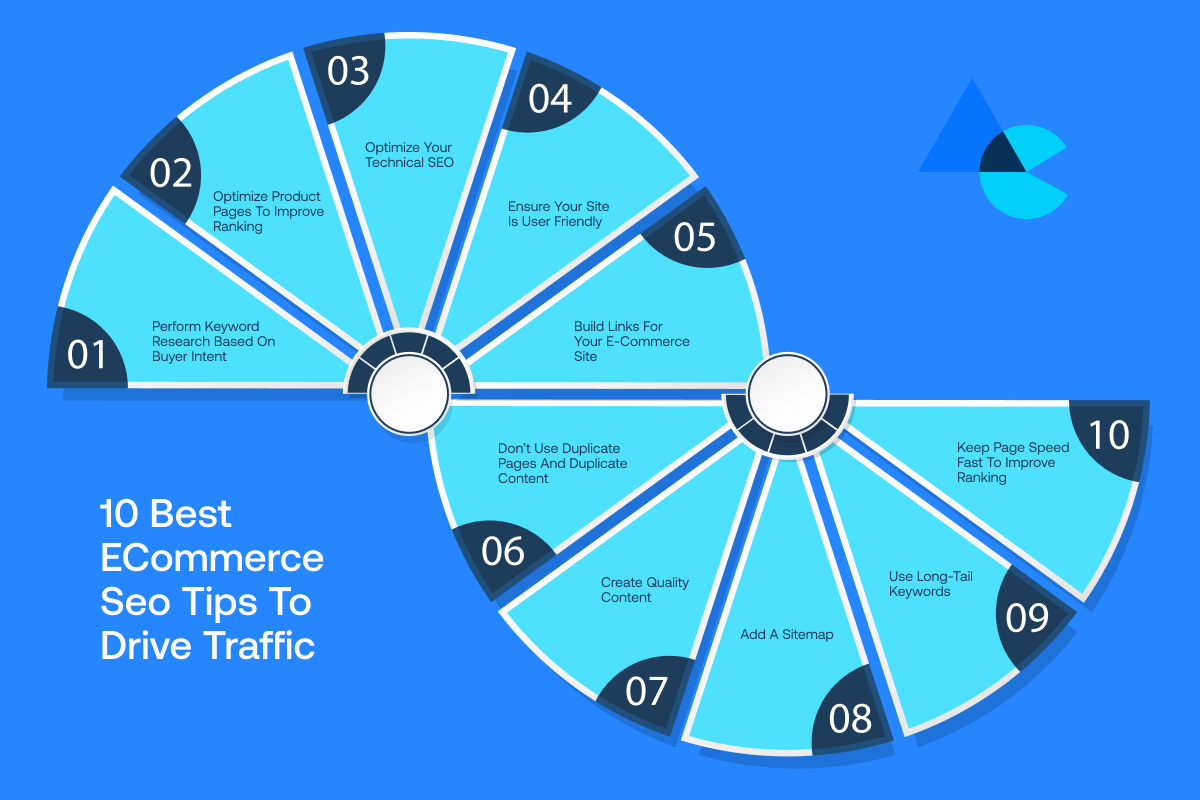
Want more people to visit your store without spending loads on ads?
Here are the top eCommerce SEO tips to help drive traffic to your online shop!
1. Perform Keyword Research Based on Buyer Intent
One of the best eCommerce SEO tips is to perform keyword research based on buyer intent. As you know, not all keywords are the same.
Some folks are merely browsing while others want to make a purchase. That’s why researching keywords driven by buyer intent is quite important.
Focus on terms that show someone is ready to purchase, like “buy wireless earbuds” instead of just “earbuds.”
Tools like Google Keyword Planner, Ubersuggest, and Ahrefs help find relevant terms with various keyword research functionalities.
Ponder intently which keywords prospective purchasers might use when hovering close to sealing a buying deal.
Adding high-intent keywords into product page titles and meta descriptions attracts buyers rather than mere browsers.
2. Optimize Product Pages to Improve Ranking
Good pictures alone won’t cut it on product pages aiming for top Google rankings. Everything from title and description and image file names needs optimization.
Begin with strategically placing the right keywords in the page title and product name for maximum effect.
Add helpful and original descriptions explaining product details thoroughly. Add features, benefits, and answers to FAQs.
Use crystal clear images and add alt text for search engines to understand. Reviews should be included whenever possible because they foster trust and boost SEO rankings.
You have to create pages that are useful for people and friendly to search engines.
3. Optimize Your Technical SEO
Technical SEO for eCommerce involves behind-scenes work that keeps your site running along nicely and catches Google’s eye.
It includes various tasks such as fixing broken links, creating clean URLs, adding meta tags, and having a secure HTTPS site.
Also, you must ensure your site is mobile-friendly. Moreover, you must make sure your site loads quickly and doesn’t confuse search engines with duplicate content.
Technical SEO makes your store appear healthy in Google’s eyes. This in turn improves rankings and makes it easy for people to discover your products.
It might sound mind-numbingly dull but remains one of the best eCommerce SEO tips for boosting traffic and staying ahead of competitors.
4. Ensure Your Site Is User Friendly
A user-friendly website doesn’t just aid online shoppers but also bolsters SEO rankings significantly thereby enhancing online visibility.
People who really like your site tend to linger longer and maybe even buy something. That sends a pretty strong signal to search engines that your site deserves a higher ranking.
Keep the layout simple and buttons easy to find with clear menus which makes your site user-friendly as well.
Avoid clutter and use legible fonts. Also, make sure your site works well on mobile devices too. Nobody likes waiting around for ages so fast loading time is a must.
A good user experience means happier customers and it boosts sales while enhancing SEO all at once.
5. Create Quality Content
Quality content gets noticed online. People look for useful content even when they aren’t searching for products like yours.
That is why you could curate blog posts like “How to Choose the Best Hiking Shoes” if you happen to sell hiking gear. This helps answer customers’ questions.
Moreover, it builds trust with users over time. Plus, Google loves websites that regularly publish helpful, original content.
Try using keywords naturally and writing in a friendly tone. You can write different types of content such as informative blogs, guides, comparisons, listicles, and tips-based pieces.
Write any piece of content that users deem useful. Your content will bring new visitors on a daily basis.
People will keep people visiting your site for information and even exchange links. All of this will improve your SEO.
6. Build Links for Your E-Commerce Site
Backlinks from other sites serve as online votes indicating your website has considerable value and is pretty trustworthy in search engine rankings.
Possessing numerous high-quality backlinks substantially increases the likelihood of achieving a high ranking in search engine results.
Acquire backlinks organically by getting in touch with bloggers for links and guest posting on popular social media sites.
More so, you can earn backlinks by getting features up in curated roundups. Partnering with influencers or offering free samples in exchange for reviews and backlinks are also some of the best eCommerce SEO tips.
Focus intently on getting links from websites related to your specific niche. Good backlinks mean more traffic plus better rankings.
7. Add a Sitemap
Sitemaps function somewhat like maps of websites helping search engines grasp what pages exist and the connections between them fairly well.
It lists all crucial pages including home and product pages as well as blogs so search engines crawl your site pretty efficiently.
Submitting your sitemap through Google Search Console can accelerate indexing so new or updated pages get crawled easily.
It’s beneficial mostly for big online stores having lots of web pages. A clear sitemap helps search engines and boosts SEO, leading to greater visibility and traffic.
8. Don’t Use Duplicate Pages and Duplicate Content
Using the same content across several web pages by copying product descriptions and pasting them can hurt your SEO.
Search engines don’t like duplicate content and struggle badly because they don’t know which page to rank.
Each page of your site has to be unique, especially your product titles and descriptions. Even if you sell somewhat similar items yet you will need to word them differently by highlighting different features and uses for every product.
Avoid creating multiple URLs showing the same content. Informative and unique content boosts site value significantly and makes Google rank pages higher in search results.
9. Keep Page Speed Fast to Improve Ranking
Speed matters a whole lot nowadays. Slow-loading websites will drive potential customers away before they get a chance to look at your product.
Also, Google notices that too. Pages that load fast keep shoppers in a good mood and help bump up your search result rankings.
You can speed things up by compressing images and removing unnecessary code. Also, you can increase site speed by getting decent hosting and using smaller file sizes.
Tools like GTmetrix and Google PageSpeed Insights can help you find what’s slowing your site down.
Faster sites generally result in lower bounce rates and a good user experience. All of this increases the chances of turning visitors into actual buyers.
10. Use Long-Tail Keywords
Long-tail keywords are longer and super specific phrases people type into search engines when they’re pretty close to actually making some purchase.
Targeting specific keywords like “comfortable running shoes for flat feet” instead of just “comfortable shoes” often attracts buyers ready for a purchase.
Ranking them is easier especially if your store is new or operates on a smaller scale. Add long-tail keywords in product titles, descriptions, and blog posts.
They help you show up in specific searches and get ideal customers thereby substantially boosting your chances of cashing in on a potential sale. It’s smart SEO!
How to Do eCommerce SEO the Right Way
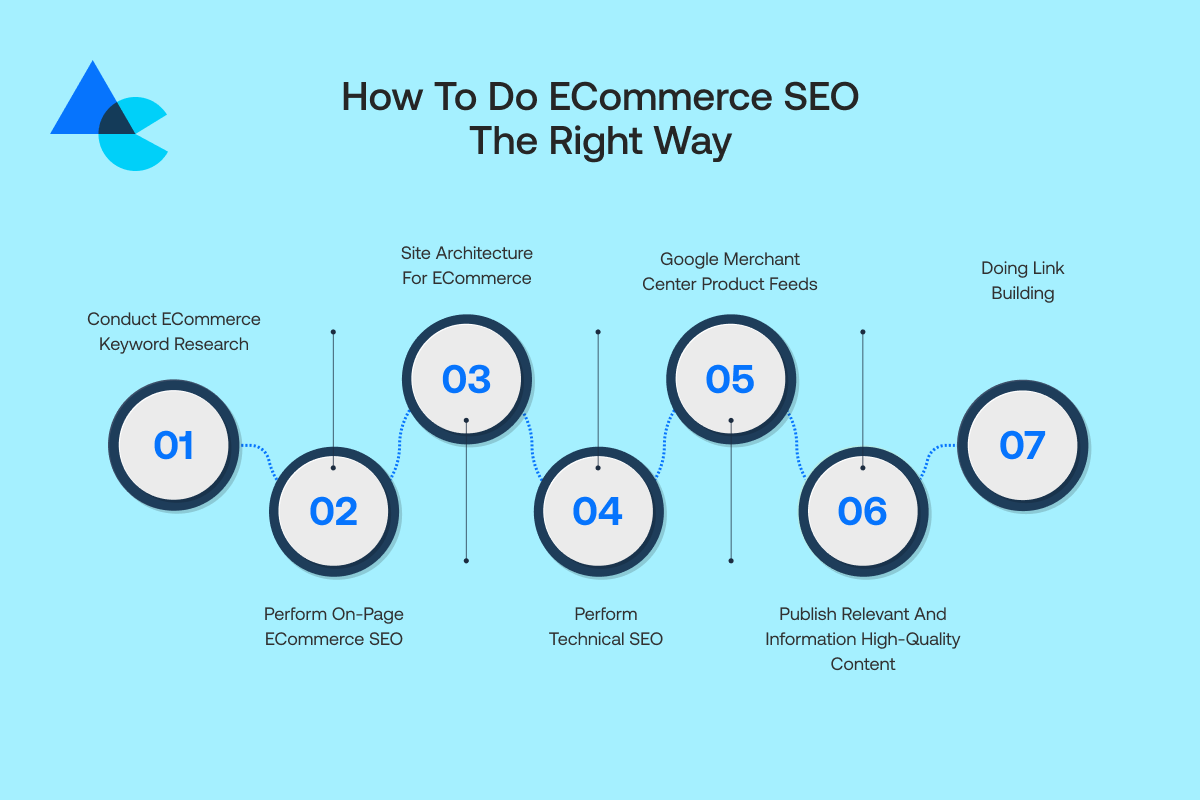
Doing SEO for eCommerce websites takes more than just keywords. From your product descriptions to your site structure, every element plays a role in your overall search visibility. For platforms like Magento, success depends on implementing tailored strategies that address its unique architecture and capabilities. You can follow these proven Magento SEO optimization techniques to enhance performance, improve rankings, and drive more traffic to your store.
Conduct eCommerce Keyword Research
First things first, your SEO starts with smart keyword research. Start searching for keywords that folks type in when they’re looking to make a purchase, not just surf around online.
Long-tail keywords such as best hiking boots for winter attract buyers having very specific needs.
On the other hand, terms like boots are broadly encompassing. Focus on volume, competition, relevancy, and intent of the KW. Match keywords to product types to get more targeted traffic.
The right keywords help you attract visitors who are more likely to buy, every SEO strategy starts here!
Perform On-Page eCommerce SEO
Once you have researched keywords, you will then need to perform on-page SEO. On-page SEO involves optimizing eCommerce website product titles, descriptions, headers, images, and URLs directly on site naturally with relevant keywords.
Craft product descriptions that are super helpful and clearly answer most customer queries. Product images should use alt text while meta titles and descriptions should be informative and distinct.
Guide visitors towards related products or collections by adding internal links throughout your webpage content.
The ultimate objective is to make your site super user-friendly for shoppers and help search engines grasp your pages better with slightly more intuitive navigation.
On-page SEO for eCommerce product pages lays crucial groundwork for other optimization techniques and getting it spot on makes ranking your site a breeze.
Site Architecture for eCommerce
Site structure heavily influences search engine crawling and indexing of pages. That’s why organizing categories, collections, and product pages matters greatly.
A simple layout helps Google and makes it easy for shoppers to find stuff they’re looking for. Ensure crucial pages are accessible within a couple of clicks from the homepage.
Use breadcrumbs and clean URLs as well as a good navigation menu. Focus on page indexing by using sitemaps and internal linking.
A well-structured site boosts content discoverability and keeps both bots and buyers happy.
Perform Technical SEO
Next up you will need to do technical SEO. Technical SEO encompasses behind-the-scenes work that facilitates smooth store operation and ranking well.
For this, you will need to fix broken links and speed up your site with HTTPS as well as make it mobile-friendly. Submit your sitemap to Google Search Console and fix the crawl errors it highlights.
Check for duplicate content and ensure each page has a unique title alongside the meta description.
Proper indexing by Google relies heavily on solid technical SEO. All your other SEO efforts and eCommerce SEO tips might fly under radar without technical SEO.
Doing SEO for retail eCommerce stores is like building a strong foundation, boring maybe, but necessary for everything else to work!
Google Merchant Center Product Feeds
You must now submit your products via feed in Google Merchant Center for them to show up pretty regularly in Google Shopping results.
This feed contains crucial product info including titles, images prices, and availability details. Ensure every listing remains regularly updated and keyword-rich with utmost accuracy.
Submitting a clean and detailed feed boosts visibility in Google’s shopping tab and gives you a chance to appear in paid product listings organically.
It’s a crucial component of SEO strategy, especially for e-commerce sites boasting an enormous product catalog and elaborate marketing tactics. The better your product feed, the easier it is for customers to find you.
Publish Relevant and Information High-Quality Content
Next is the content publishing bit. You will need to publish helpful content that attracts traffic from all types of people whether they are ready for a purchase or not.
Blog posts and how-to guides alongside comparison articles help answer lots of questions your target audience has. Write content in a friendly tone while using keywords naturally.
Create engaging content around stuff that resonates really well with your products such as “How to Choose Really Cool Yoga Mats” or “Gifts Pet Owners Love”.
Super high-quality rich content keeps visitors hanging around on site for quite longer and builds trust as well.
This content ranks on Google eventually and earns backlinks as well. Quality content turns readers into customers. It’s a savvy method for bolstering store presence online.
Doing Link Building
The last thing you will need to do to perform your site’s SEO is get backlinks from other websites.
Doing so signals Google that your online store is credible and important. Start off by writing guest posts.
You can write helpful articles for blogs within your niche. Also, include a link back to your online store in it.
You can also get press mentions by reaching out to journalists. Or you can submit stuff to gift guides and use services like HARO (Help A Reporter Out). Quality links from good sites help boost search rankings.
Those links can also drive traffic to your site. Link building takes considerable effort but ultimately proves worthwhile. That is because it boosts traffic and strengthens your store’s SEO.
Best Tools for Performing eCommerce SEO
Using the right eCommerce website optimization tools makes SEO easier and more effective.
Here are some of the best tools to help you track, improve, and grow your online store’s SEO.
Google Analytics
Google Analytics sheds light on online store visitors and their activities from various geographic locations.
It monitors visitor count on your site and time spent there while pinpointing the most clicked pages daily.
Sources of traffic such as search engines, social media, or ads sending most visitors can be identified right there too.
Such data aids you in figuring out stuff working pretty well and areas needing improvement over time. This is a must-have tool for all eCommerce sites.
Ahrefs
Ahrefs is a powerful tool for finding the best keywords, checking out what your competitors are ranking for, and discovering backlink opportunities.
It reveals top traffic-generating pages on your site and search terms people use while also assessing competitors’ SEO strength.
Ahrefs can be used for fixing broken links and finding keyword ideas. It’s great for planning content, boosting rankings, and building a smarter SEO strategy for your store.
Audit Tools
SEO audit tools, like Screaming Frog, SEMrush, or Ubersuggest, help find problems on your site that might be hurting your SEO.
These tools scan websites for issues like broken links, missing meta tags, duplicate content, and slow-loading pages.
You can get a pretty comprehensive report on stuff that needs fixing with just one scan. Regular audits keep your site healthy and fast for users and search engines to navigate.
Why Choose Artisticore for Your eCommerce Website’s SEO Optimization?
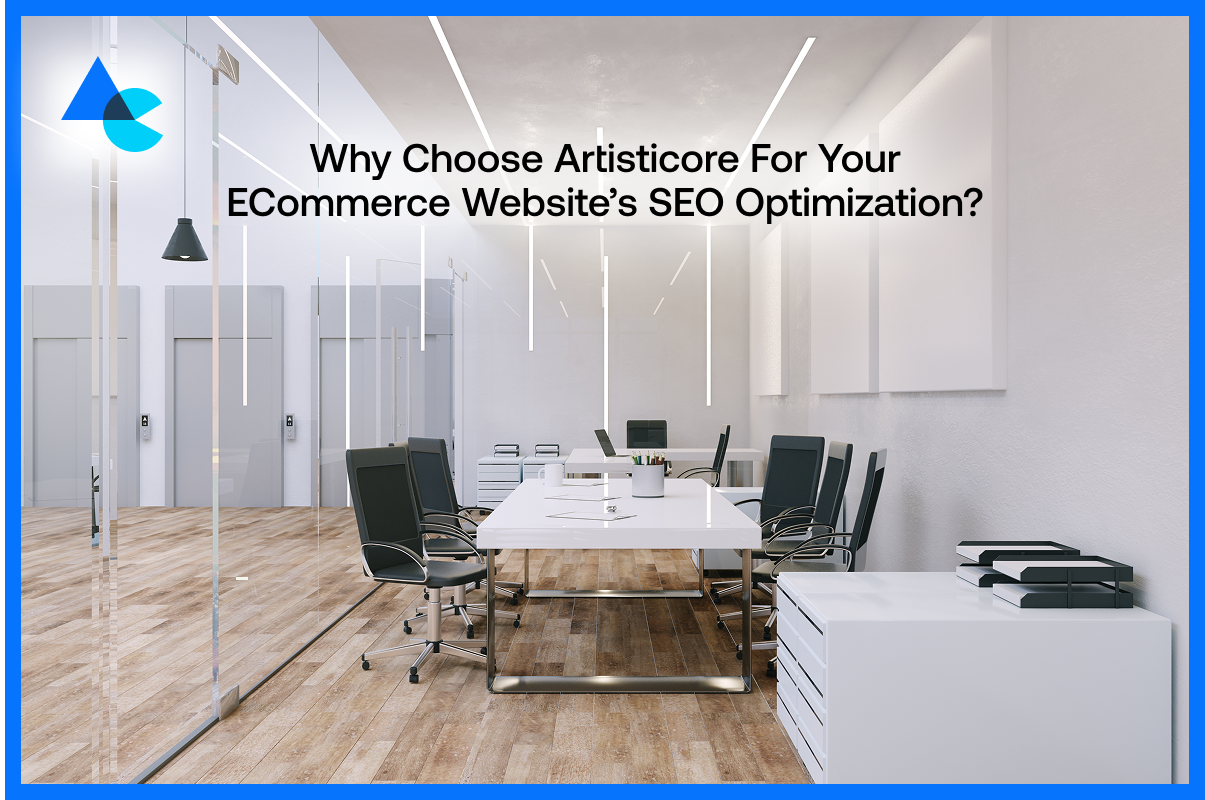
At Artisticore, we build websites that people can find. Our team knows precisely how blending savvy design with SEO strategies can help your online store get seen.
We handle everything from keyword research and content creation to fixing technical issues and increasing site speed.
Our eCommerce SEO company will tweak our SEO strategy depending on whether you’re a startup or an enterprise.
Artisticore has SEO experts who optimize your site’s SEO to drive targeted traffic that turns into actual sales. We’ll take care of behind-the-scenes work so you can focus on scaling your brand and getting sales.
So partner with Artisticroe as we do SEO for online store using eCommerce SEO tips and Shopify SEO tips to drive results.
Final Thoughts
SEO for eCommerce stands out as the best method for bringing lots of prospective customers without paid promotional campaigns. SEO helps build long-term success rather remarkably by attracting highly relevant visitors and significantly boosting visibility online. At the end of the day, it’s all about good customer experience and high sales numbers. Your store can stand out in a crowded market by leveraging the right eCommerce SEO tips and getting customers ready to make a purchase.
And if you need to do SEO optimization for your eCommerce website, then you can consider Artisticore for the job. Our team has the SEO skills to pay the bills and will help your store rise in search results. We’re here to guide you every step of the way. Let Artisticore turn your website into a traffic magnet and a sales machine.
